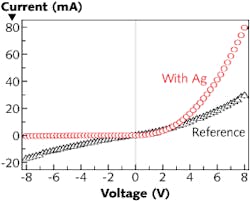Silver-enhanced silicon nitride LED is efficient integrated-photonics source
One of the more difficult problems in creating silicon (Si) photonic circuits with active components is that no practical and efficient silicon-based light sources exist (hybrid circuits containing germanium-based or III-V light sources can be used instead). One possible approach, introducing nitrogen (N) to create SiN integrated LEDs, does result in light production but is still not very efficient. A group at Zhejiang University (Hangzhou, China) is working to remedy this by adding a layered structure that contains silver (Ag) islands 50–80 nm in size, resulting in the formation of efficiency-raising localized surface plasmons.
The researchers created an LED containing such a structure and compared it to a similar SiN LED that lacked the structure. Both LEDs emitted broadband electroluminescence from 400 to 700 nm, but the Ag-island LED had an output at 550 nm that was enhanced by a factor of 14 at a 25 mA current. In addition, the Agisland device could be driven at a current of more than 40 mA, while the control device burned out at 25 mA. The applied voltage was higher for the control device in these experiments but when the voltage was made the same (6 V) for both devices, the new LED had an integrated electroluminescence 480 times greater than the control device. The current-voltage characteristics of the new device were quite different, too. Contact Dongsheng Li at [email protected].

John Wallace | Senior Technical Editor (1998-2022)
John Wallace was with Laser Focus World for nearly 25 years, retiring in late June 2022. He obtained a bachelor's degree in mechanical engineering and physics at Rutgers University and a master's in optical engineering at the University of Rochester. Before becoming an editor, John worked as an engineer at RCA, Exxon, Eastman Kodak, and GCA Corporation.
